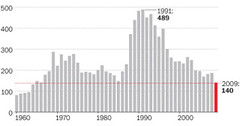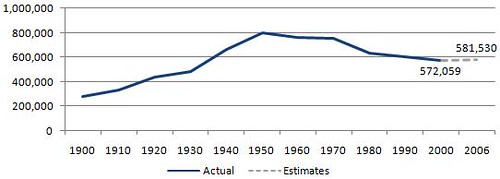Reflecting national central-city trends, DC population rises while crime plummets

Posted January 5, 2010 at 1:39PM
New end-of-year data confirm what some of us have been reporting for a long time: central cities in the US are no longer in decline. This is great news for the environment, since it is more evidence that sprawl is losing its hold on the American psyche.
In Washington, DC, where I live, a steady trend of population growth in the last decade has reversed years of population loss caused by middle-class flight to the suburbs. In 2009, that growth (a net gain of 9,583 residents) was larger than anything seen since the 1940s. A story in The Washington Post, written by Carol Morello and Tim Craig, further reports that last year’s gain was due in significant measure to residents moving into DC from other US municipalities, not just immigration from other countries as in previous years.
DC’s population may have already surpassed the 600,000 mark for the first time in two decades. The official Census estimate of city’s population as of July 1, 2009 was 599,657. In a news conference last week, DC mayor Adrian Fenty noted that the District’s rate of growth in 2009 was greater than that seen in all but four states (Wyoming, Utah, Texas and Colorado). Demographer William H. Frey of the Brookings Institution is quoted in Morello and Craig’s story as observing that "What we've seen is a frozen suburbanization nationwide, and the District has been part of it."
(DC's population stopped declining in the 2000s. Source: DC Govt)
DC city council member Jack Evans says that things started to improve in Washington during the mayoral administration of Anthony Williams, Fenty’s predecessor: "The whole image of the District of Columbia began to change from a dangerous, dirty, unsafe place to a very different city"
That change is also reflected in the latest crime statistics, which show a sharp continuing decline in violent crime in both the central city and its most diverse suburban municipality, Prince George’s County, Maryland. Another Post story, written by Allison Klein, reports that DC and Prince George’s, “long considered the region's most violent jurisdictions, logged their lowest homicide totals in years in 2009, with D.C. hitting a 45-year low.” Other suburban jurisdictions also reported a decline.  The story notes that, although DC registered a particularly large decline (25 percent, compared to 2008), it is significant that crime is dropping across the entire region because “when violence is tamped down in one area, it often gets pushed to a neighboring jurisdiction.”
The story notes that, although DC registered a particularly large decline (25 percent, compared to 2008), it is significant that crime is dropping across the entire region because “when violence is tamped down in one area, it often gets pushed to a neighboring jurisdiction.”
Crime in other US central cities (the article cites New York, Philadelphia and Chicago) declined around ten percent last year. While this does not mean that all is well, the trend does bode well for those of us who believe that urban revitalization is essential to sustainability.
So does the population trend, perhaps even more so since it indicates a return of confidence in DC and other cities. I have to note, though, that at least in the case of DC the population reversal means that the city is becoming more diverse and younger, something that is regarded with suspicion in some circles (see also this blog post). While there should be no turning back on these trends, city leaders and smart growth advocates must remain sensitive to the understandable fears of once-disenfranchised populations that do not want to lose their voices. We are a long, long way from that now, however, and in the meantime let’s celebrate how far we have come and encourage the urban revival.
